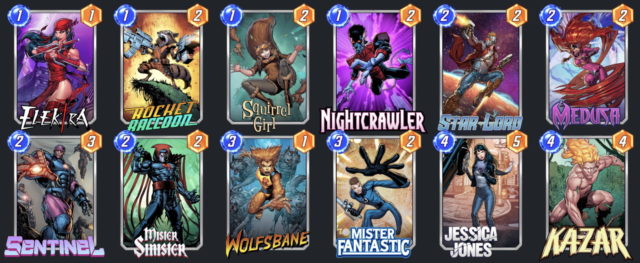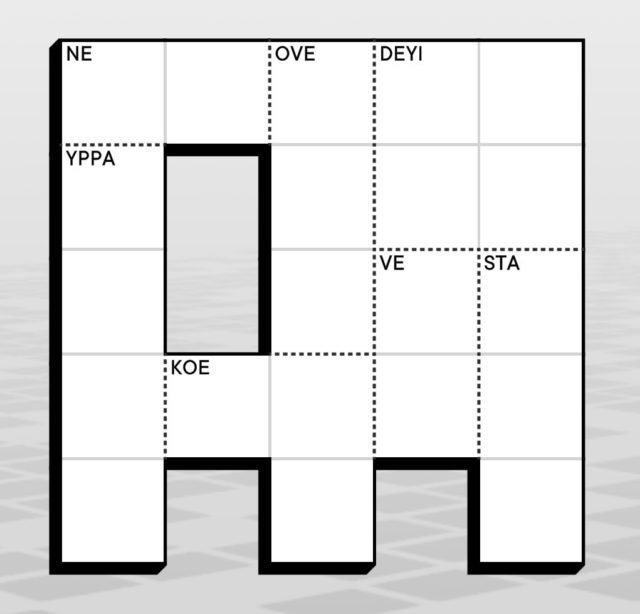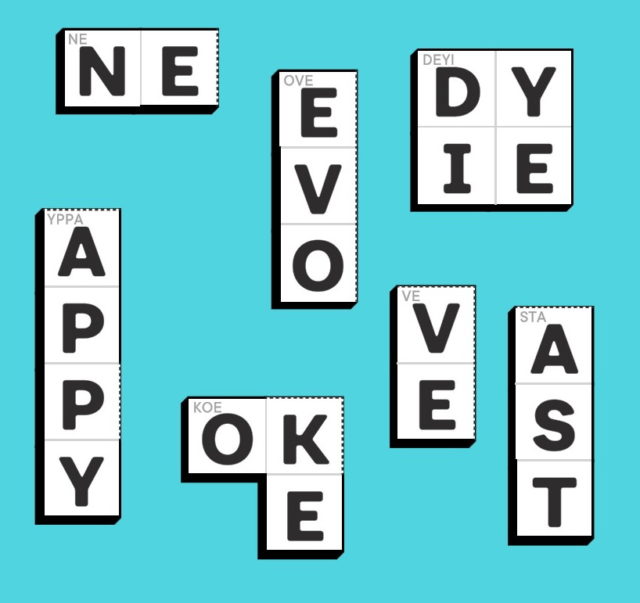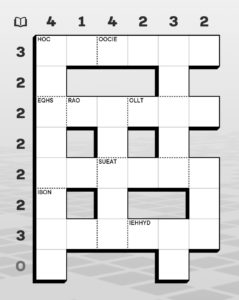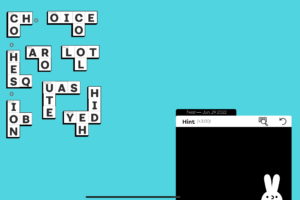Marvel Snap is on online “collectible” “card” game which was publicly released in late 2022. I signed up for it – maybe even a little before that when it was still in beta, I don’t remember – and played it for a month or two in the fall of 2022 because I was looking for a new casual game on iOS. But after a little while I got bored with it and stopped playing.
Then this past September I was feeling pretty unhappy with last year’s Magic the Gathering sets (basically, I’ve hated the limited formats for most of them, and especially loathed Wilds of Eldraine, the set which was out at the time) and decided to give it another try, and I’ve been playing it regularly since.
As a casual and simple game it has a surprising amount of depth. I don’t really care about the character skins that the cards have, so it’s the gameplay which has held my attention. Enough that I decided to write an entry about it.
Collecting
The game is a “collectible” “card” game in that the game pieces are virtual cards, and you acquire them by consistent play. You can’t trade with other players, and for the most part you have little control over how you acquire cards. The game has a “collection level” system which you move up as you play, and over the first 500 levels you acquire every card in the first two “pools” of cards. Thereafter you gradually acquire cards from the later pools (3, 4 and 5). Effectively, this means everyone gets a base set of cards after a couple of months of play, and then players randomly acquire new cards to unlock new deck archetypes.
There are a couple other ways to acquire cards: Certain cards become randomly available for purchase through certain means in the store, and every “season” (month) a new “pass” is released with a new card which you can purchase. I’ve been buying the season pass for the last few months at $10 each and have been pretty happy with it.
Each card had a ladder of rarities which you can increase as you get “boosters” and credits. These rarities just make the card look different, which has no in-game value, but increasing the rarity moves you up the collection level track. You get boosters by playing, and you get credits by achieving daily and mastery pass goals, and you also get boosters and credits by moving up the level track.
So it’s a pretty clever gamified system, and for me the motivation is to acquire new cards to unlock new decks and experience, so I keep playing. A pretty nifty feedback system. I’m sure there are people who spend real money to unlock
Gameplay
A game consists of 3 zones, and each player may have up to 4 cards in each zone. The player with the most power in each zone at the end of the game wins that zone, and you have to win 2 of the 3 zones to win the game. (If you tie for numbers of zones won, then the player with the highest total power wins.)
The game lasts 6 turns, and each turn a player gets an amount of energy equal to the turn number, losing any unspent energy each turn. Each card has an energy cost, a power number, and may have special abilities.
Each player constructs a deck of 12 unique cards from the cards they own. They start the game with 3 cards, and draw 1 card each turn. And each turn they can play as many cards they have in hand as they have energy.
One thing that took me a while to realize is that this means you’ll draw 9 of the 12 cards in your deck during the game, so well-constructed decks have a fairly consistent experience, varying mainly in the order they draw cards in, and which 3 cards they don’t draw.
I’ve also noticed that some players don’t seem to think about having to win only 2 of the 3 zones and work to win all 3 of them, whereas I’m happy to punt on a zone in order to win the other 2.
The game keeps things simple by limiting your options to basically only which cards you play. If a card has an effect which could choose from among several different things – for example, discard a card, destroy a card, affect a card in some other way – the game makes the choice randomly. There are a few combos which can result in a number of effects happening in sequence, and when this happens the game will “fast forward” to the end of the sequence. I don’t think the game has any truly infinite combos, which must be an interesting design tightrope to walk.
Oh, one more thing: Each zone has a randomly-chosen effect which are revealed over the course of the first 3 turns, from left to right. There are a lot of zone effects, so every game is a little different, and some of them are very different. Some decks can be completely hosed by a particular set of zones, while others do well with them. Those are unusual, though: Most decks are competitive with most zones, but the games play out differently. And it feels great to win a game with a set of zones that your deck handles poorly.
I haven’t yet figured the optimal strategy for playing cards while some zones are still unknown. Early on I would play in the leftmost zone – revealed on turn 1 – with my first card, but these days I tend to play in the rightmost zone unless a revealed zone makes it clear I should play something there. Sometimes this hoses me, other times it benefits me, but on balance it’s felt like the right thing. I imagine whole articles have been written about how to do this.
Other Stuff
Each season has a separate ranking track based on “cubes”, which are acquired by winning games, and lost by losing games. Each game starts at 1 cube, and either player can “snap” at any time to double the number of cubes won, up to a maximum of 8. These get you some additional rewards, but mean you have to be snapping cleverly to win more cubes than you lose. This is frankly one of the less exciting parts of the game for me.
I’m not really sure how matchmaking works in Marvel Snap. I suspect they try to match you up roughly based on your collection level and maybe the season rank. I find I don’t often match up against decks which are clearly better than mine, but I also find that I tend to get up to 85 cubes and then stall out (the max reward is at 100 cubes). This probably means I’m missing out on some marginal value in my snapping, but I’ve seen people say they get up to max cubes in just a few days, so maybe not.
But the fact that I can keep moving up in collection level matters a lot more to me than getting stalled on cubes.
(It seems like optimally people would retreat when clearly behind with little chance of catching up and snap when clearly ahead with little evident chance of losing, and so most games would end up at 1-2 cubes. and advancement would be slow. In practice, this doesn’t happen, which is interesting. I often win 8-cube games where I felt ahead for a long time, and I sometimes lose 8-cube games because my opponent had stuff I hadn’t imagined which caught them up. I suspect there are built-in factors which stoke the variance, but also that there are aspects of this part of the game I haven’t figured out yet. I also suspect that some players just snap early because they like to play for higher stakes – the equivalent of a live straddle in poker – and that many people like to play out the game because you get more boosters for longer games. I dunno.)
As I said, there are also various challenges – daily ones for everyone, and extra ones for people with the season pass – which you can accomplish to get more credits. These are usually pretty easy to achieve – I’m not sure I’ve ever not achieved one with a few games of play per day.
Decks
Deck building is a pretty interesting part of the game. There are of course loads of web sites out there with decks you can build – if you have those cards. If you don’t, then you often look for a deck where you have 8-10 of the cards, and then figure out what to fill in around them. The new card with each season pass is fun because you can try to build some new decks around them.
I’m going to present a few of my decks without going into them in great depths; you can easily go online to see what the cards do if you care.
When I started playing I decided what I wanted to do was maximize the number of cards I could play, so I built a deck called “Micronauts” which looked like this:
These are all tier 1 and 2 cards, and it performed really well for me. Basically these cards are all good-rate cards which put a lot of power on the board for their cost, and I could almost always play all of them by the end of the game. So if you’re new to the game, consider going this one a try. I’ve evolved the deck over time – primarily based around Squirrel Girl, Ka-Zar (which gives all 1-cost cards +1 power) and Jessica Jones – and it’s still pretty competitive. I bring it out whenever there’s a daily challenge where it wants me to win a zone with 4 cards.
I think my favorite deck came with the season pass for Ms. Marvel a few months ago. She is already an efficient card (5 power for 4 energy), but she gives adjacent cones 5 power if the cards in each zone have different costs. I looked at a few decks out there and then came up with this one:
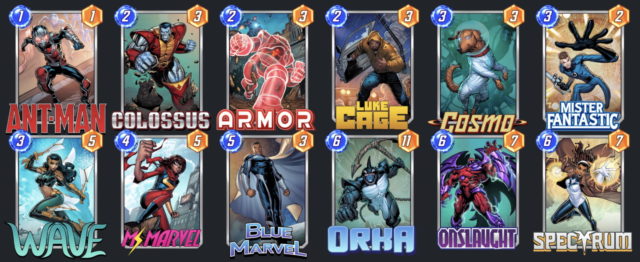
I’m not sure I’ve actually changed this deck since I built it, and it wins a lot. Besides the basic synergies in the deck, I stumbled into a couple of cards – Armor and Cosmo – which absolutely hose a few popular decks in the metagame. There are few warmer feelings than dropping Armor – which prevents all cards in a zone from being destroyed – in a zone where a deck which wants to destroy its own cards has already played 2 or 3 cards.
This deck strongly prefers to play cards in the middle zone. I feel it could use a little more tuning, and perhaps someday I’ll acquire a new card which is an obvious replacement for one of the ones in it today.
My current favorite deck is this High Evolutionary deck. The gimmick of the High Evolutionary is he gives certain cards special abilities, but the nature of those abilities is that they give you a bonus for not using all your energy, and they give you a bonus if you decrease the power of your opponent’s cards.
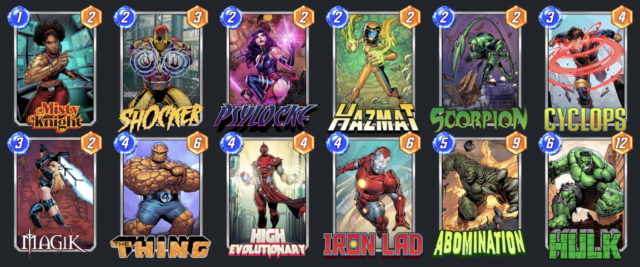
I don’t own a few cards commonly played in this deck, but I’m very happy with the cards I put in instead. Psylocke grants extra energy which can either ramp out cards or assist in the “not use all energy” bonuses. Scorpion and Hazmat both decrease power of opponents’ cards, making Abomination cheaper. Magik adds a 7th turn to the game, so you can play more stuff. And Iron Lad gets the ability of the top card in your deck, in addition to being very efficient, and synergies with most of the deck. It’s been a very consistent deck for me over the last week.
I have several other decks I play, but those have been my go-to decks so far.
In Conclusion
So I’ve been playing Marvel Snap almost every day for the last 4+ months, and frankly I’m kind of surprised it’s held my attention for this long. A single game takes just a few minutes, so I’m not investing a huge amount of time in it, and overall I’ve been winning at a pretty good clip, which always feels good.
So if you enjoy turn-based card strategy games like this, and either enjoy to can tolerate the play-to-acquire gamified system, then Marvel Snap may be for you. I don’t know if I’ll still be playing it at the end of the year, but if Magic sets continue to have sucky limited environments, then I just might.

